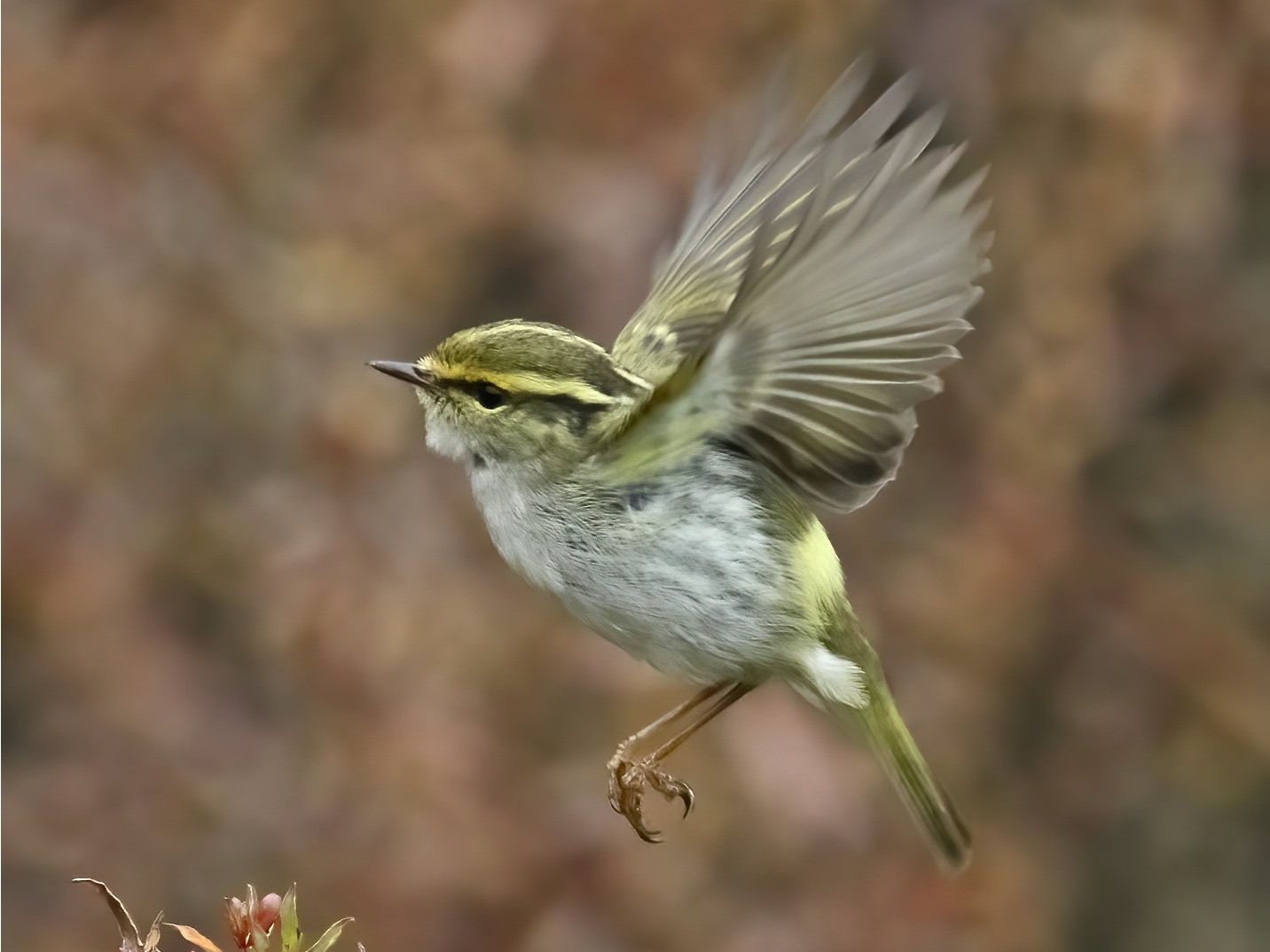Pallas’s Leaf Warbler Phylloscopus proregulus 黃腰柳鶯
Category I. Uncommon to common winter visitor and passage migrant to wooded areas.
IDENTIFICATION

Feb. 2015, K. C. Kong.
9-9.5 cm. Small, short tail, large head and round body with small bill. Bicoloured supercilium (yellowish front half, whitish rear), dark eye stripe broad behind the eye, two wing bars (broad and obvious on greater coverts), dark bases to secondaries, yellowish fringes to flight feathers and narrow whitish edges to tertials.

Feb. 2018, Cherry Wong.
Obvious pale central crown stripe bordered by dark green median crown stripes. Pale yellowish rump obvious when hovering or foraging low down. Very active foraging behaviour.
VOCALISATIONS
The call is a distinctive nasal ‘dzuee’, ‘dzee’, ‘dzuip’ or similar that rises in pitch terminally.
The song is unlike most Phylloscopus in the region as it does not consist of repeated phrases. Instead, it is a continuous medley of fairly high-pitched trills and other notes that carries quite far.
DISTRIBUTION & HABITAT PREFERENCE
Although recorded from a variety of wooded areas, including shrubland, mangrove and open-canopy woodland, densities are highest in closed-canopy forest where in some years it forms a substantial component of mixed-species foraging flocks. It appears in mangrove mainly on spring passage.
There was a small increase in the percentage of 1km squares occupied in the winter atlas surveys from 26.4% in 2001-05 to 29.8% in 2016-19. The broad distribution was the same, however, and concentrated in areas of closed-canopy woodland and shrubland, which probably explains the increase.
OCCURRENCE
Uncommon to common winter visitor and scarce passage migrant with extreme dates of 19 October in both 2019 and 2020, and 14 May 2013. Less common than Yellow-browed Warbler in the early part of the winter, but usually more numerous in closed-canopy forest in late winter.
In autumn numbers increase rapidly to a peak in the first week of December, followed by a fall that suggests some passage occurs (Figure 1). This is then followed by a further increase until the first week of January when the wintering population is at its peak. From the second week of January there is a gradual decrease in numbers until the first week of April, after when it is rare.
The highest count on record is 100 at Tai Po Kau on 13 December 1996 and in the much smaller area of Hong Kong Cemetery on 6 January 1977, while the highest since 1999 is 85 in the Tai Po Kau – Leadmine Pass – Shing Mun area on 3 January 2013. There is a suggestion that counts are now lower than they were.
It was noted as an abundant winter visitor by Swinhoe (1861) and was also recorded in winter by Herklots (1953), Dove and Goodhart (1955) and Walker (1958).
BEHAVIOUR, FORAGING & DIET
Fast-moving, livewire foraging action that, more than other Phylloscopus warblers in HK, employs hovering and short flycatching sallies. Forages both in the canopy and in shrubs, and in prolonged cold weather will come to atypical sites such as the damp bottom of channelised watercourses. Small flocks may also be seen taking advantage of late afternoon sun in glades, along forest paths or at the edge of streams. Takes insects, small spiders and larvae.
Calls less frequently than Yellow-browed Warbler, and so actual numbers present are easy to underestimate. On warm days in early spring low-intensity song is often heard, mainly from early March to the end of passage, and rarely in the second half of January and first half of February. Up to 20 birds have been noted singing in any given area. Utters song from within canopy.
RANGE & SYSTEMATICS
Monotypic. Breeds in southeast Siberia from northwest Mongolia and the adjacent area west of Lake Baikal east through northeast China and Ussuriland to the coast, including Sakhalin; winters in south and east China as far north as Beijing where it is uncommon (Alström et al. 2020, Birding Beijing 2022, Liu and Chen 2020).
CONSERVATION STATUS
IUCN: Least Concern. Population trend stable.
Figure 1.

Alström, P., P. Clement, and G. M. Kirwan (2020). Pallas's Leaf Warbler (Phylloscopus proregulus), version 1.0. In Birds of the World (J. del Hoyo, A. Elliott, J. Sargatal, D. A. Christie, and E. de Juana, Editors). Cornell Lab of Ornithology, Ithaca, NY, USA. https://doi.org/10.2173/bow.palwar5.01
Birding Beijing (2022). https://birdingbeijing.com/the-status-of-the-birds-of-beijing/ (Accessed 23 September 2022).
Dove, R. S. and H. J. Goodhart (1955). Field observations from the Colony of Hong Kong. Ibis 97: 311-340.
Herklots, G. A. C. (1953). Hong Kong Birds. South China Morning Post, Hong Kong.
Liu, Y. and Y. H. Chen (eds) (2020). The CNG Field Guide to the Birds of China (in Chinese). Hunan Science and Technology Publication House, Changsha.
Swinhoe, R. (1861). Notes on the ornithology of Hong Kong, Macao and Canton, made during the latter end of February, March, April and the beginning of May 1860. Ibis 1861: 23-57.
Walker, F. J. (1958). Field observations on birds in the Colony of Hong Kong. Hong Kong Bird Watching Society, Hong Kong (duplicated).

